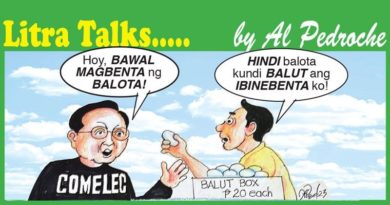COLUMNISTS: . LOOKING BACK- The continuing Marcos revisionism

The continuing Marcos revisionism
.
Finance Secretary Sonny Dominguez correcting Sen. Imee Marcos online regarding the failure of her father’s Masagana 99 (M-99) program has marked him out for roasting at a future privilege speech. But that’s nothing compared to the fate of Archimedes Trajano, then a 21-year-old student who dared ask, in a public forum in August 1977, why then 21-year-old Imee was appointed to head the Kabataang Barangay. Trajano was whisked out of the venue by security agents, and two days later his mangled remains were found, suggesting a slow death by beating and torture. Trajano’s mother filed and won a case against Marcos in Hawaii, but the US court decision granting her over $4 million in damages could not be enforced in Manila. In a Senate press release dated May 21, 2020, Marcos declared: “Contrary to Dominguez’s claim, the Philippines did export rice to neighboring countries when farmers under Masagana 99 produced a surplus of some 89,000 metric tons in 1977 to 1978, according to Dr. Emil Q. Javier, an agronomist and former president of the University of the Philippines.”


Memento MaximaDigital Mktg.
@ [email protected]
RESERVE ADVERTISEMENT
A simple Google search will lead you to the 2016 Javier article that said of Masagana 99: “Contrary to detractors’ claims, the program actually achieved its avowed objective of growing more rice and achieving self-sufficiency, albeit for only a brief period immediately after the program was launched in 1973. (Italics underscore what was conveniently left out of the Marcos “praise release.”)


Memento MaximaDigital Mktg.
@ [email protected]
RESERVE ADVERTISEMENT
While Javier did admit that M-99 significantly increased palay yield and produced a rice surplus that was exported in 1977, he advised against its repeat. His conclusion goes against the Marcos revision of history: “…Sadly, Masagana 99 proved to be short-lived and unsustainable mainly due to the costly subsidies and failure of many farmers-borrowers to repay the loans… Giving away seeds, fertilizers, pesticides and dryers, while politically attractive, is temporary, wasteful and prone to graft. We have been doing that all these years with little to show for the expense and the effort.”


Memento MaximaDigital Mktg.
@ [email protected]
RESERVE ADVERTISEMENT
A more detailed account is in UP Professor Ed Tadem’s 1986 paper, “Grains and Radicalism: The Political Economy of the Rice Industry in the Philippines, 1965-1985.” It has been three decades since Ferdinand Marcos died, disgraced and exiled in Honolulu—high time that an objective evaluation of his legacy be undertaken by history and historians. There is a mountain of information that needs to be mined and validated. Stories are not always easily fact-checked, like the conflicting claims on Masagana 99.


Memento MaximaDigital Mktg.
@ [email protected]
RESERVE ADVERTISEMENT
During the enhanced community quarantine, I have been trawling online sources. The New York Times and other periodicals that uploaded and indexed their old issues provide hours and hours of fun. But nothing beats the Foreign Relations of the United States series, accessible through the US Secretary of State’s Office of the Historian site. Some very surprising confidential documents have been declassified and annotated as a first step in Marcos research efforts. While these documents provide a view of Marcos and martial law from the US Embassy in Manila and policymakers in Washington, these are but tips of the proverbial iceberg. So much more material remains classified at the National Archives and Records Administration in Washington or the various presidential libraries of Johnson, Nixon, Ford, Carter, and Reagan, whose papers can shed more light on the US relationship with Marcos from 1965 to 1986.


Memento MaximaDigital Mktg.
@ [email protected]
RESERVE ADVERTISEMENT
Also largely untapped are 23,000 pages of documents from the National Security Archive: cables, briefing papers, memoranda, reports, court records, intelligence reports, etc. that document US policy toward the Philippines during the Marcos years. Although the late 20th century is not my primary research area, I spent a day dipping into this resource at the Cornell University Library, amazed that it had everything from the length of Marcos’ golf clubs to the list of items confiscated by the US Customs in Hawaii after the Marcos family’s arrival in February 1986.


Memento MaximaDigital Mktg.
@ [email protected]
RESERVE ADVERTISEMENT
In 2022, it will be 50 years since Marcos declared martial law in September 1972; a martial law museum is scheduled to open in UP Diliman that year. It should contain more than horror-show exhibits on human rights violations in this dark period; a library is also essential to counter the ongoing historical revision that seeks to make us move on and forget.
Comments are welcome at [email protected]


SIGN UP TO RECEIVE OUR EMAILThe most important news of the day about the ASEAN Countries and the world in one email: [email protected]
.









